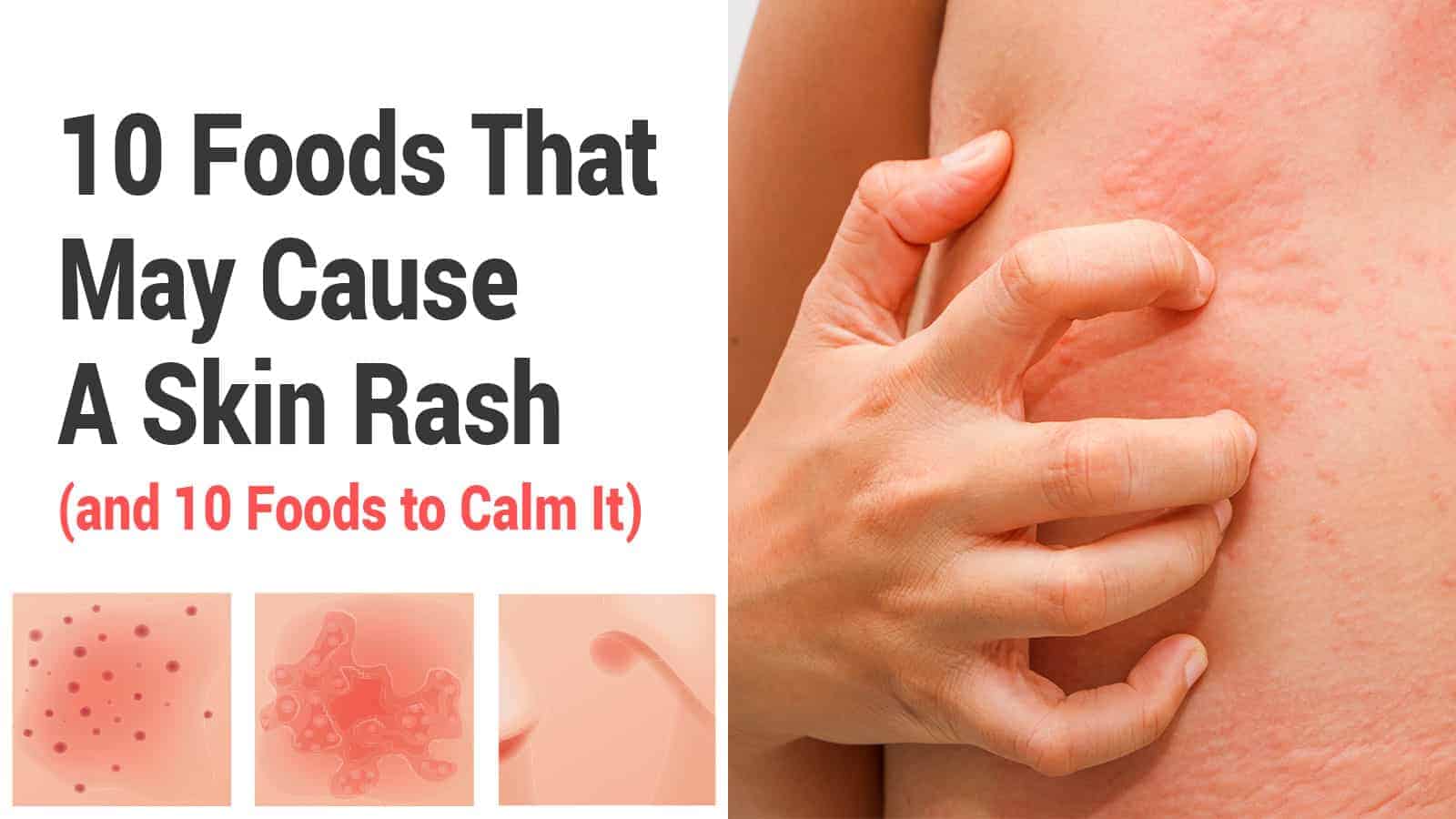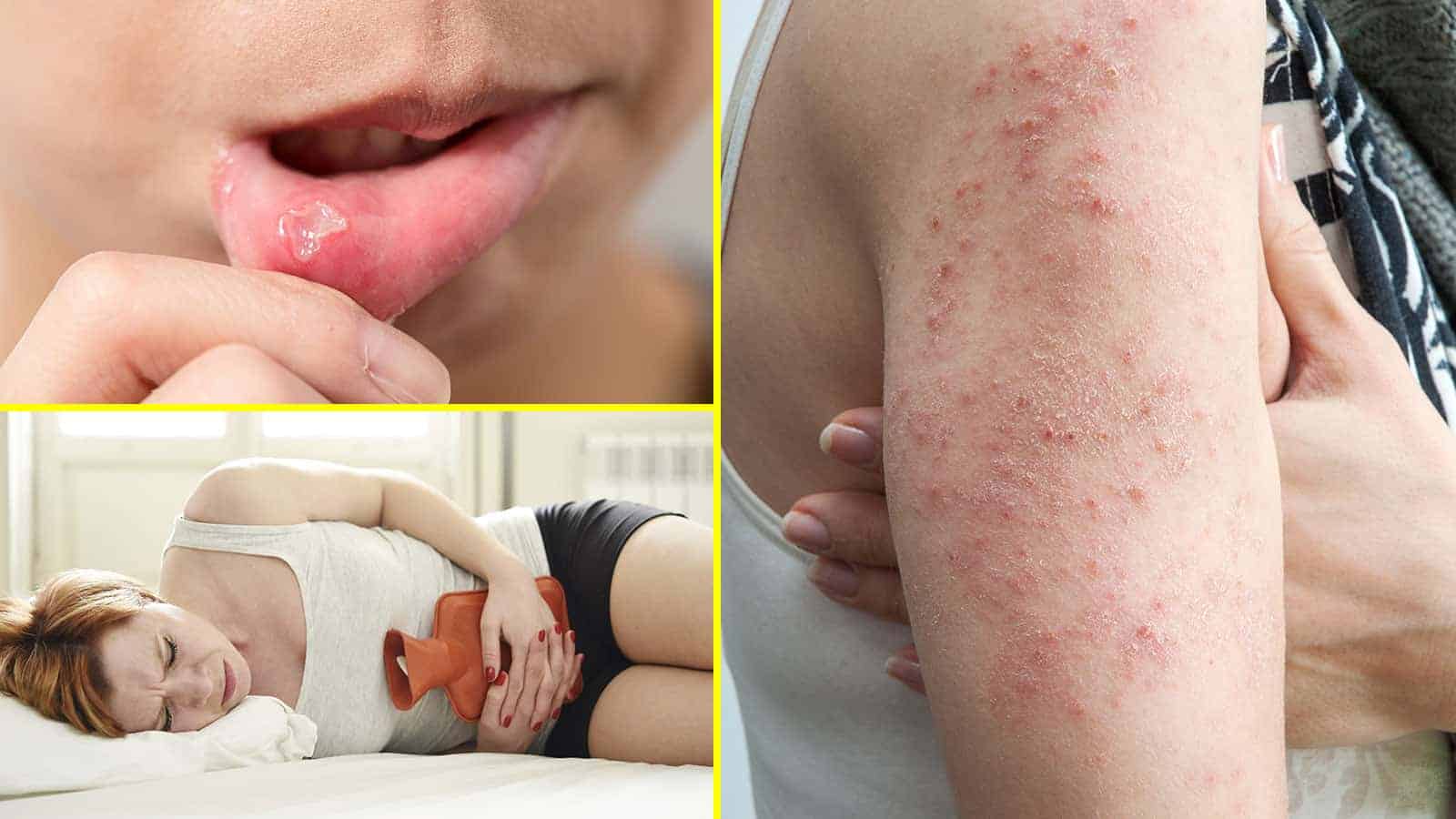Skin rashes from eating certain foods are worrisome. The itchy, red, bumpy rash appears on your face, neck, or around your mouth soon after you eat. A skin rash can pop up on your hands or arms when you touch certain foods. You may wonder if you should eliminate certain foods from your diet. So, what foods make skin rashes worse? What foods will help calm this type of breakout?
Your diet might be the cause of your skin rash!
There’s a growing awareness that the food you eat affects every part of your health. If you have a food allergy, you may be prone to skin rashes. Research studies found that your diet can set off eczema. Eczema is a word used to describe a group of skin conditions that cause inflammation, itchiness, red, dry, or bumpiness of your skin.
Most of the time, eczema refers to a condition called atopic dermatitis. If you eat food you’re allergic to your body goes into overdrive. Your immune system’s overreaction releases mast cell chemicals that cause a hypersensitive reaction like histamines.
A reaction can happen minutes or hours after eating the food. Some delayed reactions occur as long as a couple of days later.
Gut and skin connection
A recent study found that scratching your itchy skin irritated by eating foods triggers your immune cells in your small intestine. The scratching sets off a gut reaction. This situation is why there may be varied reactions in people with food allergies. Your food allergy can set off atopic dermatitis or stomach problems or both. You may get a skin rash from foods without a stomach reaction, but some researchers suggest that if you have one result, you are prone to the other response. So, what are common food allergy symptoms? Here is a list you may encounter if you’re allergic to certain foods:
- Hives
- Itchiness or eczema (atopic dermatitis)
- Tingling around or inside your mouth
- Red skin
- Swelling of your face, lips, tongue or throat-see your doctor right away
- Wheezing, trouble breathing-see your doctor right away
- Dizziness, lightheadedness
- Vomiting
- Diarrhea
- Watery eyes
- Abdominal cramping
- sneezing
Ten foods that worsen your skin rash
There’s an increasing number of food allergies, especially in developed countries. If you think you have a food allergy, contact your doctor or allergist. They will ask for your medical information, a blood test, and a skin prick. It takes all of this information to figure out if you’re allergic to food. Blood tests alone aren’t as practical. Certain foods are the most common ones to cause allergies. Here are the top ten foods that can give you a skin rash due to an allergic reaction.
1. Peanuts
Peanut allergies are widespread. Sometimes peanut allergies are life-threatening, causing anaphylaxis or trouble breathing. Even a small bite can cause an allergic reaction for some people.
A peanut allergy is your immune system mistaking the peanut proteins as dangerous. Your immune system releases mast cell chemicals such as histamines into your bloodstream, giving you an allergic reaction. An allergic reaction may occur minutes after you’re exposed to peanuts. Skin rash symptoms to peanuts include stuffy nose, skin reactions like hives, swelling, or redness over a large area.
2. Tree nuts
Tree nut allergies are increasing, and the reactions can be acute. Part of the reason for the growing number of tree nut allergies is that they’re being used more and more in baked goods and processed foods. Studies found that nine tree nuts cause the most allergic reactions. These include:
- Walnut
- Pistachio
- Cashew
- Pecans
- Hazelnuts
- Pine nut
The Food and Drug Administration added other tree nuts as potential allergens. These include:
- Beechnut
- Butternut
- Chestnut
- Chinquapin
- Coconut
- Ginkgo nut
- Hickory nut
- Lychee nut
- Pili nut
Tree nut reactions can be life-threatening. The same study reported that 70% to 90% of all food-related anaphylactic deaths are from tree nuts. They can also cause severe atopic dermatitis.
3. Cow’s milk
Cow’s milk is another common allergy that causes skin rashes. If you’re allergic to cow’s milk, your immune system will overreact to the protein in milk from the cow. Further, if both parents have atopic dermatitis from a milk allergy, the chances of a child having this allergy increase 40% to 60%.
4. Eggs
Egg allergies are more common in kids than adults. But there are cases of adult-outbreak egg allergies. A reaction may happen within minutes of eating an egg. Symptoms include skin rashes, hives, congestion, or digestive problems. These can range from mild to more severe reactions such as hives-red welts on your body. Many people have an egg intolerance which is similar to an allergy, but not life-threatening. It can last a person’s entire lifetime.
5. Soy
Soy allergies that cause eczema, or atopic dermatitis, is more common in children than adults, but if you had a soy allergy that caused skin rashes when you were younger—good chance you’ll be allergic to soy as an adult. Allergic reactions to soy may include a flushed face, hives, or tingling inside your mouth. Eczema symptoms are red itchy skin, scaly areas on your skin. Some people have more severe symptoms such as swelling of the lips, face, tongue, or throat.
6. Wheat
Wheat allergies are especially common. Studies show that an allergic reaction to grain occurs when your body makes antibodies to the proteins that are in wheat. Gluten is one protein that causes this type of immune response. Studies reported that wheat allergies worsen atopic eczema in some adults. Wheat can be found in a variety of foods and even everyday items. Places you’ll find wheat include:
- Bread, pasta, crackers, cereals, cookies, and cakes
- Condiments, salad dressings, sauces, soy sauce
- Deli meats, hot dogs, other processed meats
- Stamps, envelopes
- Play-doh
- Cosmetics
- Bath items
- Medications-used as a binder
- Pet food
- Chewing gum
7. Seafood
Many adults in the United States have a seafood allergy. It’s more common in adults than in kids. Kids that have a seafood allergy will typically grow out of it as they get older. Allergic reactions to seafood can cause hives, tingling in your mouth and throat, swelling, or stomach upsets like vomiting and diarrhea.
Some people have a more dangerous reaction, causing breathing problems or blood pressure drops that can be life-threatening. Seafood that triggers allergic reactions include vertebrates, which include fish that have a backbone such as salmon, tuna, halibut, trout, haddock, eels, and rays.
It’s easy to get exposed to seafood in unexpected ways, including.
- Asian food restaurants
- Fish and chips restaurants-They use the same oil for cooking foods, so you get contaminated
- Anchovies in Caesar salads
- Worcestershire sauce
- Contaminated barbeques when several types of meats and fish are cooked on the same grill.
- Drinking out of glassware treated with a product called “Isinglass.” It’s used to remove a cloudy film from beer and wine. It’s made from the swim bladder of some fish.
8. Shellfish
Invertebrates (no backbone) can also cause an allergic reaction.
- Shrimp
- Lobster
- Mussels
- Crab
- Oysters
- Crayfish
- Mollusks
- Clams
- Octopus
- Squid
- Calamari
- Sea slug
- Prawns
Typically, shellfish allergies cause vomiting, diarrhea, shortness of breath, face, lips, or throat swelling. Reactions are often delayed by a couple of hours.
10. Corn
Corn is a less common food allergy than some foods. Allergic reactions to corn may differ depending on how allergic you are to the grain. Hives or skin rash are common. Corn products are used today in lots of different foods such as
- Jams
- Syrups
- Sauces
- Beverages
- Meats, deli meats, hot dogs
- Cereals
- Candy
- Snack foods
Ten foods that can calm your skin rash
So, now you know what foods can worsen your skin rash, but there are foods that can help calm down your skin rash. You’ll be surprised to see the various foods you may not have known could calm down your uncomfortable skin rash.
1. Asparagus
Who would have thought asparagus would help calm your skin rash reactions. It’s actually prebiotic with lots of inulin. Inulin feeds healthy bacteria found in your gut like bifidobacteria and lactobacilli. Asparagus is high in Vitamin B and antioxidants.
2. Fermented foods
Fermented foods are good for your gut, which in turn helps your entire body when you’re fighting off a food allergy. Foods and drinks like sauerkraut, kimchi, miso, kefir, kombucha, sourdough bread, and Greek yogurt are healthy fermented foods to help calm your allergic reactions.
3. Pineapple
Pineapples contain bromelain, a chemical that helps digest acid and breaks down proteins to fight off stomach problems. It’s so tangy and sweet, it’s hard to think this juice can help relieve food allergy symptoms, but it does.
4. Plants and Herbs
There is a growing awareness of how plants and herbs help us stay healthy. Herbs have been used medicinally for centuries, although in the United States, it’s been more in the last 25 years or so that doctors and scientists are seeing the benefits of recommending herbs and plants for their patients.
Here are three herbs that calm your skin rashes.
- Aloe vera-Aloe has been used to ease skin disease for thousands of years. It’s known to heal skin wounds, plus studies found that aloe vera kills certain bacteria and fungi.
- Marigolds-Marigold flowers made into a tincture can be used on skin inflammations.
- Lavender- Lavender has a reputation for being a calming scent. It slows down the release of histamines that cause allergic reactions.
6. Raw onions
Raw onions are prebiotics with strong antioxidant properties. They’re packed with Vitamin C, which helps your immune system.
7. Apple cider vinegar
Some are surprised to learn that apple cider vinegar is another healthy food that can calm skin rashes. ACV kills micro-organisms plus antioxidant results. It also helps with reducing your weight, lowering cholesterol, and controlling symptoms of diabetes.
8. Ginger
Ginger is packed with antioxidants that help elevate stress. It’s especially helpful to lower your blood pressure, help with chronic diseases and aging.
9. Dandelion greens
These recognizable plants are some of the best detoxifying plants. They’re full of fiber, antioxidants, prebiotics. Dandelion greens contain vitamin A, iron, Vitamin B, and calcium.
10. Garlic
Raw garlic isn’t just a smelly plant. It’s full of inulin, which helps your gut’s good bacteria. It’s full of vitamins. Selenium and a powerful compound that kills diseases. It’s a powerful healing plant. Eating it can help you soothe your skin rashes.
Final Thoughts on Eating Well to Heal a Skin Rash
Food allergies can be stressful, especially if you’re worried about what kind of allergy reaction you’ll have. Some food allergies are life-threatening, so you need to be aware of what you eat. If you accidentally eat the food, you will need to be prepared to treat yourself or get treatment.
Fortunately, there are many foods you can take to help calm down your eczema and any skin rash that may happen when you have an allergic reaction.

















 Community
Community

